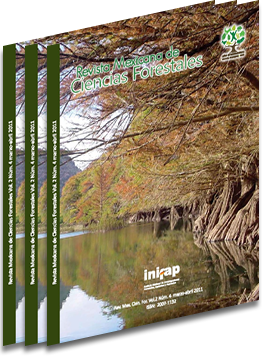FORESTRY AS THE FIRST OPERATION OF WOOD TRANSFORMATION
DOI:
https://doi.org/10.29298/rmcf.v2i4.597Keywords:
Wood quality, competition, tree cover, fertilization, sanitation, forestryAbstract
Forestry offers an array of possibilities to adequate the quality of the wood to its use, not only because of the different ways of improving its physical and mechanical properties, which is also possible in a small scale, but for reducing its anomalies and alterations and if needed to increase or enhance them. This paper shows the different factors and properties that are usually more involved in defining wood quality and the influence that forestry has in each of these factors is analyzed. Among forestry operations, the management of the shifts (rotation period) is one of the most viable options to improve wood quality, to increase its yield on transformation processes, to reduce per cent of juvenile wood, knots, pith, growth tension and to increase the relation between sapwood and heartwood. All these factors affect their quality for its diverse uses; even the increment of the risk of ring and heart shakes in some species can cause wood deterioration. In addition, the effects of tree cover or forest cover are also analyzed through the plantation spacing, thinning and clear cuts, fertilization and the sanitary cuts.
Downloads
Downloads
Published
How to Cite
Issue
Section
License
The authors who publish in Revista Mexicana de Ciencias Forestales accept the following conditions:
In accordance with copyright laws, Revista Mexicana de Ciencias Forestales recognizes and respects the authors’ moral right and ownership of property rights which will be transferred to the journal for dissemination in open access.
All the texts published by Revista Mexicana de Ciencias Forestales –with no exception– are distributed under a Creative Commons License Attribution-NonCommercial 4.0 International (CC BY-NC 4.0), which allows third parties to use the publication as long as the work’s authorship and its first publication in this journal are mentioned
The author(s) can enter into independent and additional contractual agreements for the nonexclusive distribution of the version of the article published in Revista Mexicana de Ciencias Forestales (for example, include it into an institutional repository or publish it in a book) as long as it is clearly and explicitly indicated that the work was published for the first time in Revista Mexicana de Ciencias Forestales.
For all the above, the authors shall send the form of Letter-transfer of Property Rights for the first publication duly filled in and signed by the author(s). This form must be sent as a PDF file to: ciencia.forestal2@inifap.gob.mx
This work is licensed under a Creative Commons Attribution-Noncommercial 4.0 International license.







